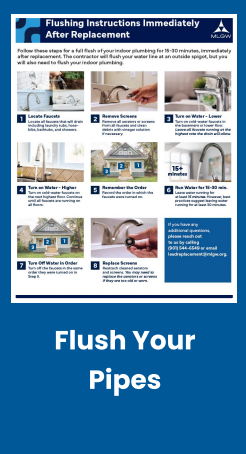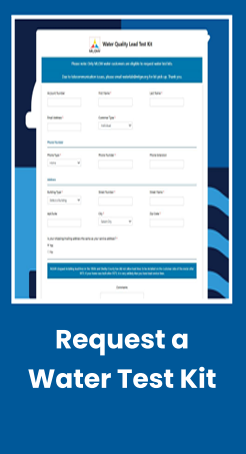

We have great water and MLGW is taking steps to keep it that way. MLGW has been replacing lead service lines since 2012 and has inspected or replaced more than 11,000 since then.

|
Lead Service Line Replacement: Watch the video to see the process in action, including what happens before, during, and after replacement. |
What is MLGW doing?
MLGW is committed to providing high-quality drinking water. As part of our proactive replacement program, MLGW is working with customers to replace their water service lines for both the utility and private side of the lines for customers served by a galvanized or lead line.
As part of this process, our contractors are visiting customers that are served by a galvanized or lead service line to discuss replacement options. Our contractors have a valid ID and may request customers sign a Right of Entry (ROE) form.
Filling out an ROE form is easy and is the first step of the replacement process. Customers can fill out a form by accessing the Resources section of our Replacement Hub.
Is my drinking water safe?
Yes. MLGW has provided Memphis residents with high-quality, reliable water since 1939. MLGW routinely tests the water for the presence of lead and other contaminants. We conduct more than 38,000 tests each year, and we filter and treat your water to ensure quality and safety. Our water is monitored throughout the year to ensure that it meets the rigorous standards set by the U.S. Environmental Protection Agency (EPA) and the Tennessee Department of Environment and Conservation (TDEC).
What steps can I take?
If you are served by a lead or galvanized service line, filling out an ROE form is the first step in the replacement program process. You can access a form here on our Replacement Hub under Resources.
In addition to actions MLGW is taking to protect you, there are some additional steps you can take to further reduce your risk from consuming water that is served by lead or galvanized pipes.
- Flush your taps by running the water for 15-30 seconds before using.
- Use only cold water for drinking, cooking, and making baby formula.
- Request to have your water tested by MLGW’s certified lab.
- Use water filters certified to remove lead.
- Clean your faucet’s screen regularly.
Flushing is a short-term measure to reduce lead or copper levels in drinking water. The more time water has been sitting in pipes, the more lead it may contain. Before drinking, flush your home's pipes by running the tap, taking a shower, doing laundry, or doing a load of dishes. “Flushing” involves opening taps and letting the water run to remove water that has been standing in the interior pipes and/or the outlets. The flushing time can vary by the type of outlet being cleared.
Step-by-step Instructions for Flushing:
- Locate faucets –Locate all faucets that will drain including laundry tubs, hose-bibs, bathtubs, and showers.
- Remove screens – Remove all aerators or screens from all faucets and clean debris with vinegar solution if necessary.
- Turn on water - lower – Turn on cold-water faucets in the basement or lowest floor. Leave all faucets running at the highest rate the drain will allow.
- Turn on water - higher – Turn on cold-water faucets on the next highest floor. Continue until all faucets are running on all floors.
- Remember the order – Record the order in which the faucets were turned on.
- Run water at least 15 min – Leave water running for a minimum of 15 minutes. However, best practices suggest leaving water running for at least 30 minutes.
- Turn off water in order –Turn off the faucets in the same order they were turned on in step 5.
- Replace screens –Reattach cleaned aerators and screens. You may need to replace the aerators or screens if they are too old or worn.
If you have any questions or concerns, please reach out to us by calling us at 901-544-6549 or email leadreplacement@mlgw.org
What if I want another water pitcher for my household?
When replacement occurs, MLGW will provide you with up to six months of water filters and a water pitcher. For more information on replacement options, please email leadreplacement@mlgw.org.
Where can I buy more water filters?
Customers can find EPA-certified lead filters and pitchers from major retailers like Amazon, Walmart, and Target, as well as directly from the manufacturers' websites like Brita. Look for products that have a specific certification, such as NSF/WQA, for lead reduction to ensure they meet EPA standards. For more information, visit the EPA’s Consumer Tool for Identifying Point-of-Use and Pitcher Filters Certified to Reduce Lead in Drinking Water
Who pays for the replacement?
Thanks to newly allocated Federal Infrastructure funds, we can replace more lines, including customer-side lines for customers who need help replacing them. MLGW is committed to working with customers to find the best options for replacing their service lines.
I have a galvanized service line? It s not lead so what is the problem?
MLGW stopped installing lead service lines in 1950, while Shelby County law did not allow lead lines to be installed on the customer side of the meter after 1973.
Galvanized service lines were an alternative to lead. Galvanized steel can trap lead particles and release them back into the water over time. As a precaution, MLGW replaces galvanized service lines, in addition to lead service lines. MLGW also treats its drinking water with an additive called orthophosphate to prevent pipe corrosion.
What if I need funding assistance for the replacement?
MLGW is committed to working with customers to find the best solution for replacing their service lines. For more information on replacement options, please email leadreplacement@mlgw.org.
How will my yard be restored after the replacement?
MLGW is committed to being a good neighbor and wants to minimize any potential disturbances. MLGW’s contractors will work to restore customers’ yards following the replacement process. This includes any driveway, soil or other restoration following any disturbance such as a small hand dig that may be required to access the service line.
Who can I call if there is a problem during replacement?
MLGW is here to answer all of your questions. For additional questions or issues with replacement, please reach out to us by calling us at 901-544-6549 or email leadreplacement@mlgw.org.
     |






.png)


